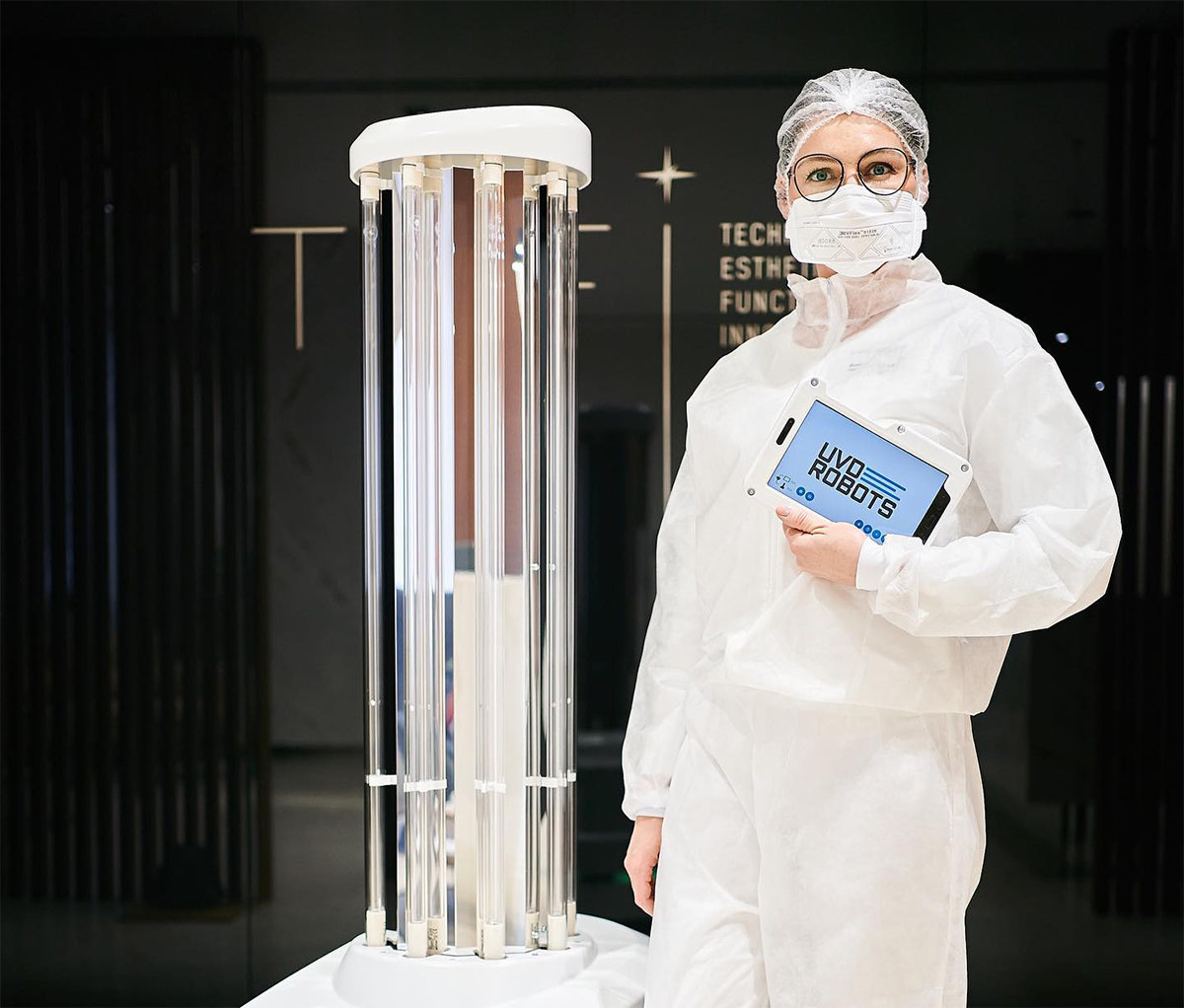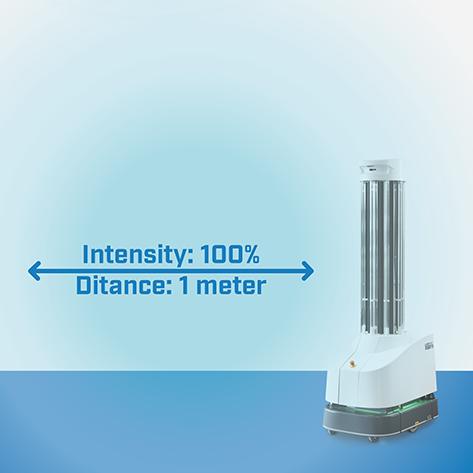Title
Content
Title
Content

UVD Robots, the pioneers in autonomous UV disinfection, leads the global market in robotic UV-C enhanced environmental surface disinfection. We offer a distinct competitive edge, providing numerous benefits when compared head-to-head with traditional static UV devices. Real-world trials demonstrate that our autonomous devices reduce overall disinfection time by up to 55% and labor time by up to 65% Furthermore, they significantly increase compliance with UV-C dose application consistency, resulting in improved efficacy.
Ultraviolet (UV) light irradiation has long been recognized as a means of disinfection for water, food, air, and surfaces. Its germicidal properties were first discovered in 1877 by Downes and Blunt1, who observed that sunlight exposure could prevent microbial growth. The first application of ultraviolet germicidal irradiation (UVGI), utilizing light between 200-360 nanometers, in a healthcare setting was recorded in 19362. Since then, organizations like the US Centers for Disease Control have embraced UVGI, endorsing its germicidal efficacy for water and air in 20033, and more recently for surface sanitization in 20194.
Even before the 2019 coronavirus pandemic, the concept of an autonomous UV-C disinfection robot was under development in Denmark. A team of robotics, software, and mechanical engineers at Blue Ocean Robotics pioneered this innovation, leading to the launch of UVD Robots' first-generation commercial device in 2018. The current Model C device was released in 2020. UVD Robots combined the germicidal power of UV-C with advanced robotics to create a self-navigating, fully autonomous UV-C disinfection device.
Autonomous UV-C devices offer a significant competitive advantage over traditional static or stationary devices. This has been clearly demonstrated in head-to-head comparison studies during customer trials. Understanding the physics of light radiation, particularly concerning shadows and distance, reveals the "why" behind this competitive edge.
UV light travels in a direct path, effectively disinfecting objects and surfaces in its line of sight with high energy. However, shadowed areas receive less or no light intensity. To counter this, the light source needs repositioning. With a static UV device, an operator must re-enter the room after each UV cycle to manually move the device, increasing labor time and the total disinfection cycle. This process may need to be repeated multiple times depending on room size to ensure full coverage. In contrast, the autonomous UVD Robot maps the room and creates a disinfection route with assigned disinfection points. This ensures direct surface irradiation and addresses shadowed areas. The UVD Robot is designed to move around objects and position itself to minimize shadows.
Beyond its powerful UV-C lamps (1,440 Watts), the UVD Robot also features tower reflectors that disseminate UV-C light 360 degrees. This eliminates the need for operator repositioning, reducing labor and disinfection time, thereby providing a significant competitive advantage.

The distance of the UV light source from a surface significantly impacts disinfection.
A surface within three feet (1 meter) receives 100% UV intensity, but this drops to 25% and 11% at six and nine feet, respectively. Static disinfection devices suffer from inconsistent light exposure due to varying distances between the device and room surfaces, especially when repositioned manually. This can lead to some areas being over-exposed while others are under-exposed. In contrast, the UVD Robot offers consistent and repeatable UV-C light exposure. Its disinfection route is precisely mapped to ensure all high-touch surfaces are within three feet of the light source, optimizing for 100% intensity throughout the room. This robotic approach eliminates the inconsistencies associated with manual device placement, providing a clear competitive advantage.
The competitive advantage of UVD Robots in the commercial market is rooted in the science behind autonomous UV-C devices. However, for those who prefer tangible proof, head-to-head comparisons were conducted during customer trials against various static devices. The following case studies highlight the real-world benefits that autonomous devices offer over existing static solutions, with the data speaking for itself.
This case study presents a direct comparison between the UVD Robot and an incumbent static pulsed xenon device at a Northeast healthcare facility.
Key findings demonstrate the UVD Robot's superior performance:
Table 1 & 2: Head-to-Head Comparison of UV Disinfection Solutions in a Large Northeast Healthcare Room: UVD Robot vs. Pulsed Xenon Static Device, 2023
|
Efficiency |
||||
|
Disinfection Cycles |
Turnover Time [Minutes] |
Disinfection Time [Minutes] |
Labor Time [Minutes] |
|
|
Incumbent Static Device |
1 |
31 |
24 |
7 |
|
UVD Robots |
1 |
13.8 |
10.5 |
3.3 |
|
Efficacy |
|||
|
Disinfection Points
|
Germicidal Dosage Target Achieved on HTS |
Disinfection Time Average Dosage Measured on HTS [avg. mJ/cm2] |
|
|
Incumbent Static Device |
3 |
1 of 18, 5.5% |
46 |
|
UVD Robots |
10 |
18 of 18, 100% |
100 |
Table 3 & 4: Head-to-Head Comparison Summary: UVD Robot vs. Pulsed Xenon Static Device (Incumbent Solution) in Northeast Healthcare Small Rooms, 2023
|
Efficiency |
||||
|
Disinfection Cycles |
Turnover Time [Minutes] |
Disinfection Time [Minutes] |
Labor Time [Minutes] |
|
|
Incumbent Static Device |
1 |
20.48 |
15 |
6 |
|
UVD Robots |
1 |
12.44 |
8.36 |
4.08 |
|
Efficacy |
|||
|
Disinfection Points
|
Germicidal Dosage Target Achieved on HTS |
Disinfection Time Average Dosage Measured on HTS [avg. mJ/cm2] |
|
|
Incumbent Static Device |
3 |
1 of 18, 5.5% |
33 |
|
UVD Robots |
10 |
18 of 18, 100% |
100 |
Case Study 2: Southwest Healthcare Facility – UVD Robot vs. Static UV-C Device
This case study presents a direct comparison between the UVD Robot and an incumbent static UV-C device, consisting of multiple emitter devices, at a Southwest healthcare facility.
Key findings demonstrate the UVD Robot's superior performance:
Table 1 & 2: Head-to-Head Comparison Summary: UVD Robot vs. Incumbent Static UV-C Device in Southwest Healthcare Large Room #1, 2023
|
Efficiency |
||||
|
Disinfection Cycles |
Turnover Time [Minutes] |
Disinfection Time [Minutes] |
Labor Time [Minutes] |
|
|
Incumbent Static Device |
1 |
36 |
16 |
20 |
|
UVD Robots |
1 |
23 |
12 |
11 |
|
Efficacy |
|||
|
Disinfection Points
|
Germicidal Dosage Target Achieved on HTS |
Disinfection Time Average Dosage Measured on HTS [avg. mJ/cm2] |
|
|
Incumbent Static Device |
3 |
3 of 13, 23% |
57 |
|
UVD Robots |
9 |
12 of 13, 92% |
99 |
Table 3 & 4: Head-to-Head Comparison Summary - UVD Robot vs. Incumbent Static UV-C Device - Southwest Healthcare Large Room #2, 2023
|
Efficiency |
||||
|
Disinfection Cycles |
Turnover Time [Minutes] |
Disinfection Time [Minutes] |
Labor Time [Minutes] |
|
|
Incumbent Static Device |
1 |
38 |
12 |
26 |
|
UVD Robots |
1 |
21 |
12 |
9 |
|
Efficacy |
|||
|
Disinfection Points
|
Germicidal Dosage Target Achieved on HTS |
Disinfection Time Average Dosage Measured on HTS [avg. mJ/cm2] |
|
|
Incumbent Static Device |
3 |
4 of 20, 20% |
71 |
|
UVD Robots |
9 |
19 of 20, 95% |
100 |